From the Trenches
The Wrath of the Hittites
By JASON URBANUS
Thursday, October 10, 2019
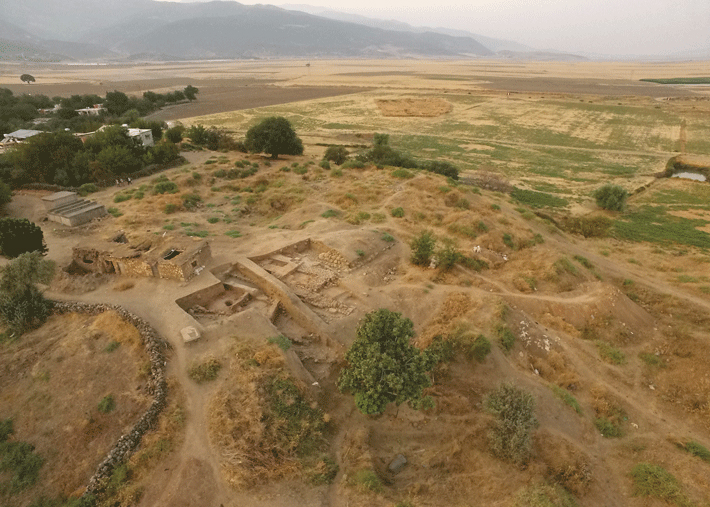 A thriving Bronze Age settlement at the site of Zincirli in southeastern Turkey was suddenly and catastrophically destroyed more than 3,500 years ago, archaeologists have discovered. A joint team from the Universities of Chicago and Tubingen uncovered two buildings that burned down, forcing their inhabitants to flee and leave behind their personal belongings. However, the layer of charred debris that covered the site preserved the buildings’ contents, including an array of bowls, drinking cups, cooking pots, storage jars, and other domestic objects. “It’s not that unusual for ancient settlements to have been burned and abandoned,” says project codirector Virginia Herrmann of the University of Tubingen, “but we were definitely surprised to find such good preservation.”
A thriving Bronze Age settlement at the site of Zincirli in southeastern Turkey was suddenly and catastrophically destroyed more than 3,500 years ago, archaeologists have discovered. A joint team from the Universities of Chicago and Tubingen uncovered two buildings that burned down, forcing their inhabitants to flee and leave behind their personal belongings. However, the layer of charred debris that covered the site preserved the buildings’ contents, including an array of bowls, drinking cups, cooking pots, storage jars, and other domestic objects. “It’s not that unusual for ancient settlements to have been burned and abandoned,” says project codirector Virginia Herrmann of the University of Tubingen, “but we were definitely surprised to find such good preservation.”
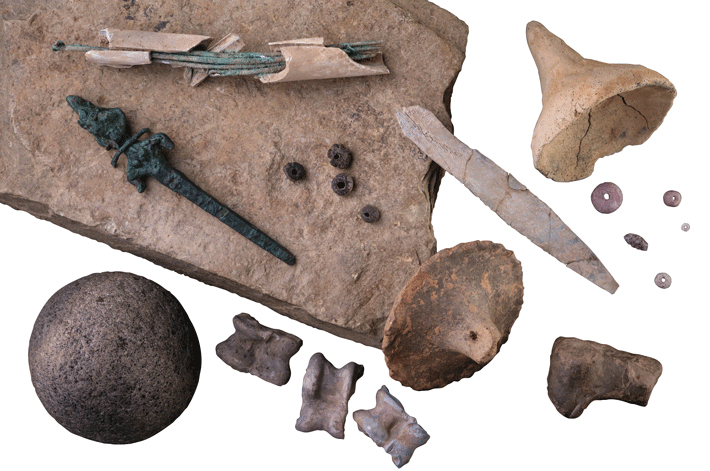 The project leaders believe that they know who was responsible for the swath of destruction: Hattusili I (r. ca. 1650–1620 B.C.), one of the first kings of the Hittite Empire, which was expanding its territory from central Anatolia during the second millennium B.C. and likely sacked the city. Says Herrmann, “The ability to connect this destruction to a known king provides a more precise historical context for our archaeological evidence.”
The project leaders believe that they know who was responsible for the swath of destruction: Hattusili I (r. ca. 1650–1620 B.C.), one of the first kings of the Hittite Empire, which was expanding its territory from central Anatolia during the second millennium B.C. and likely sacked the city. Says Herrmann, “The ability to connect this destruction to a known king provides a more precise historical context for our archaeological evidence.”
Off the Grid
By MARLEY BROWN
Thursday, October 10, 2019
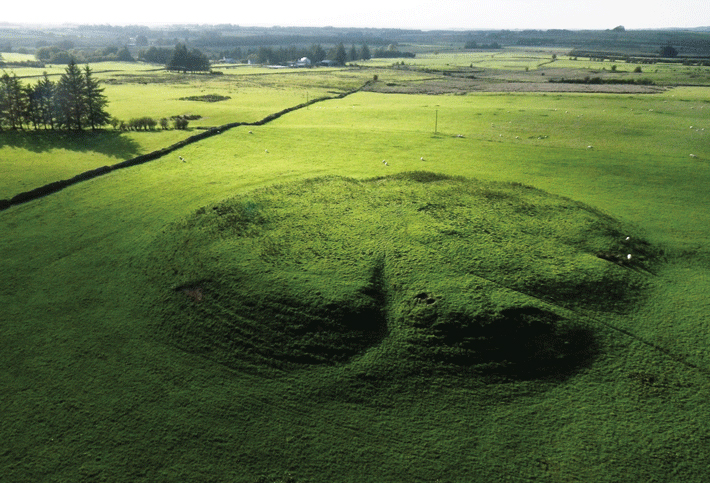 Rathcroghan, in western Ireland, covers more than three square miles and contains at least 240 archaeological sites spanning the time period from the Neolithic to the late medieval era. Its inhabitants began to raise animals and farm around 3,500 years ago, and went on to build stone structures and earthworks, remnants of which can still be seen. Rathcroghan is known not only from these monuments, but also from its pride of place in Ireland’s rich literary canon. The site is recorded in medieval accounts to have been a primary location for the ancient óenach, a ceremonial assembly featuring gatherings of legal scholars, boisterous feasts, and competitions of strength. It is also described as a burial place for Gaelic nobles and as the royal seat of the Connachta, who ruled western Ireland in the early Middle Ages.
Rathcroghan, in western Ireland, covers more than three square miles and contains at least 240 archaeological sites spanning the time period from the Neolithic to the late medieval era. Its inhabitants began to raise animals and farm around 3,500 years ago, and went on to build stone structures and earthworks, remnants of which can still be seen. Rathcroghan is known not only from these monuments, but also from its pride of place in Ireland’s rich literary canon. The site is recorded in medieval accounts to have been a primary location for the ancient óenach, a ceremonial assembly featuring gatherings of legal scholars, boisterous feasts, and competitions of strength. It is also described as a burial place for Gaelic nobles and as the royal seat of the Connachta, who ruled western Ireland in the early Middle Ages.
Rathcroghan features prominently in a collection of tales known as the Ulster Cycle, providing the setting for the beginning and the end of Ireland’s national epic, the Táin Bó Cúailnge, or the Cattle Raid of Cooley. Rathcroghan’s most notable landmark—Rathcroghan Mound—perches at the summit of a glacial ridge and measures nearly 300 feet across and 20 feet tall. Geophysical surveys of the mound suggest it may have been built up gradually over generations, possibly starting from a monument first constructed during the Bronze Age, and that an impressive building may have once stood at its top. “The mound is the center of the entire landscape, around which many of Rathcroghan’s barrows, ringforts, and standing stones are arranged,” says archaeologist and Rathcroghan site manager Daniel Curley.
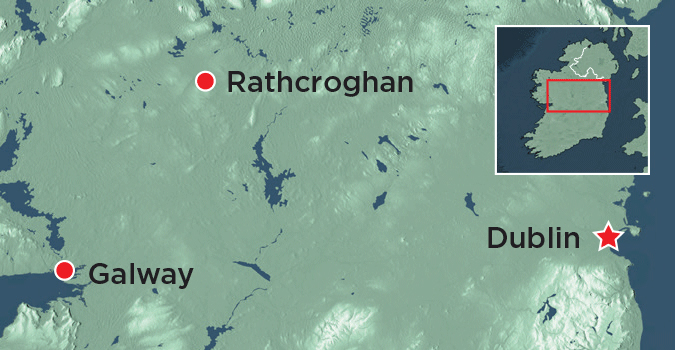 THE SITE
THE SITE
The full Rathcroghan experience begins at Rathcroghan Visitor Centre in the village of Tulsk. There, audiovisual presentations provide an overview of the area’s history, and display cases present artifacts uncovered nearby. From the visitor center, a minibus tour departs for the top of Rathcroghan Mound, where visitors can appreciate the landscape’s full panorama before stopping at specific sites. These include Oweynagat, or the Cave of the Cats, a cavern referenced in Ireland’s epics as a possible entrance to the otherworld, and a likely place of origin for the festival that eventually became Halloween.
WHILE YOU'RE THERE
History buffs who also appreciate a bit of nature can easily get lost amid the ruins of Rindoon, an abandoned medieval town about 30 minutes south of Rathcroghan by car. The fortified settlement, once home to more than 1,000 people, sits on a peninsula in Lough Ree, one of Ireland’s largest lakes. Well-signposted walks pass by buildings and fortifications dating to the thirteenth century, when the area was beset by brutal wars fought between native Irish nobles and Norman barons.
Proof Positive
By MARLEY BROWN
Thursday, October 10, 2019
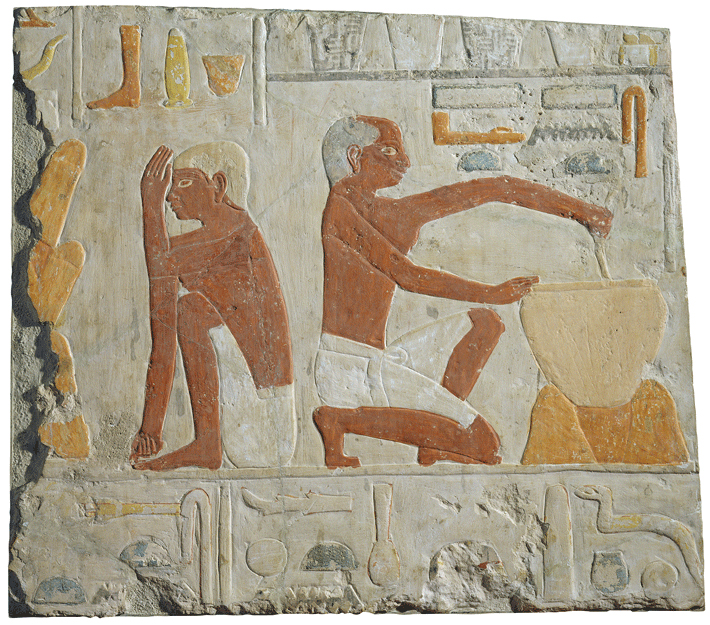 Nothing lives forever—except maybe yeast, which can go dormant and hibernate, perhaps indefinitely. An archaeologist, a biologist, and a baking enthusiast have recently embarked on a collaborative project to revive and reuse millennia-old yeast. They believe they have succeeded in identifying, isolating, and even baking bread with strains of yeast that may have been used by Middle Kingdom Egyptians to make bread—and brew beer—more than 4,000 years ago.
Nothing lives forever—except maybe yeast, which can go dormant and hibernate, perhaps indefinitely. An archaeologist, a biologist, and a baking enthusiast have recently embarked on a collaborative project to revive and reuse millennia-old yeast. They believe they have succeeded in identifying, isolating, and even baking bread with strains of yeast that may have been used by Middle Kingdom Egyptians to make bread—and brew beer—more than 4,000 years ago.
Archaeologist Serena Love of the University of Queensland is interested in brewing beer using Egyptian recipes, which scholars have attempted to piece together by studying tomb paintings and analyzing the microstructure of starch preserved in the archaeological record. Love, along with tech inventor and dedicated baker Seamus Blackley, set out to acquire ancient yeast strains that have secure archaeological provenance. They contacted museums across the United States and beyond, requesting to access their collections and extract yeast from Egyptian ceramics, stressing that the vessels would not be damaged. Eventually, they were given permission to work with artifacts housed at the Museum of Fine Arts, Boston, and Harvard University’s Peabody Museum.
To help devise a noninvasive method of collecting the yeast while minimizing contamination, the team recruited University of Iowa biologist Richard Bowman. He, too, is interested in re-creating ancient beers and has developed a yeast-extraction method—still being refined—that aims to preserve the condition of antiquities while avoiding surface contaminants. Foremost among these threats is airborne wild yeast, which, like all manner of fungi and bacteria, is all around us. Bowman’s method involves using a needle-less syringe filled with liquid containing yeast extract, dextrose, and amino acids to moisten a cotton ball that has been placed on the surface of the artifact. “We continue soaking that particular area of the vessel until it is completely saturated and the cotton ball stops drying out,” Bowman explains. After waiting five to 10 minutes for the liquid to penetrate the pores of the ceramic and “wake up” the yeast, the process is reversed. The syringe sucks the liquid back up through the same cotton ball and, finally, any harvested yeast is isolated and incubated.
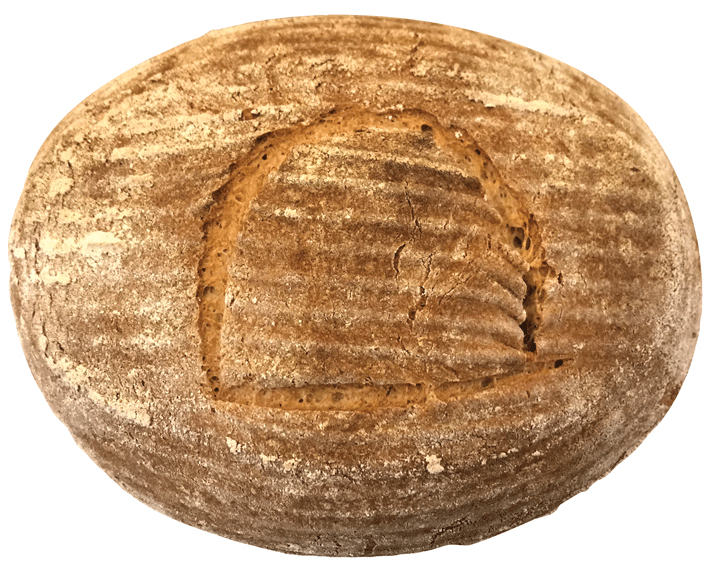 Bowman says that it may never be possible to completely eliminate the risk of contamination, and admits that the strains the team has thus far worked with may belong to ambient yeast floating around the museums. He was heartened to discover, however, that while the ostensibly ancient yeast did not take well to being grown in a modern lab, it responded immediately to conditions under which it would have grown in antiquity. “When Seamus put the yeast in emmer flour, which is what they would have been eating in ancient Egypt,” Bowman says, “it immediately proliferated.”
Bowman says that it may never be possible to completely eliminate the risk of contamination, and admits that the strains the team has thus far worked with may belong to ambient yeast floating around the museums. He was heartened to discover, however, that while the ostensibly ancient yeast did not take well to being grown in a modern lab, it responded immediately to conditions under which it would have grown in antiquity. “When Seamus put the yeast in emmer flour, which is what they would have been eating in ancient Egypt,” Bowman says, “it immediately proliferated.”
Love is now attempting to gain access to a broader range of artifacts from various periods and regions of ancient Egypt. She hopes to investigate differences in yeast used to brew the dozen or so varieties of beer that ancient Egyptians are thought to have produced. The team also plans to send out strains of yeast for genome sequencing. “We can determine the yeast’s subspecies,” explains Bowman, “and by consulting a database of genetic information collected on yeast, we can then compare the strain to its descendants.” This should allow the team to create a model of gene transformation over time that will help estimate how old the extracted yeast is. For his part, Blackley says the bread made from the (most likely) ancient yeast was like nothing he’s ever tried. “I was a little concerned about its texture,” he says. “But when it came out of the oven, I could smell that it was going to be fantastic.”
Advertisement
Advertisement
IN THIS ISSUE
From the Trenches
Proof Positive
Off the Grid
The Wrath of the Hittites
Melting Season
Provincial Pen Pal
Megalithic Mystery
Worlds Apart
The Lead Standard
Egypt's Temple Town
Æthelburga's Local Church
Down by the River
Rise of the Greek Crane
Jetting Across the British Isles
World Roundup
Island hopping to Australia, Dead Sea Scroll survival, Roman social security, and the village Canada forgot
Artifact
Another face in the crowd
Advertisement

Recent Issues
-
 May/June 2024
May/June 2024
-
 March/April 2024
March/April 2024
-
 January/February 2024
January/February 2024
-
 November/December 2023
November/December 2023
-
 September/October 2023
September/October 2023
-
 July/August 2023
July/August 2023
-
 May/June 2023
May/June 2023
-
 March/April 2023
March/April 2023
-
 January/February 2023
January/February 2023
-
 November/December 2022
November/December 2022
-
 September/October 2022
September/October 2022
-
 July/August 2022
July/August 2022
-
 May/June 2022
May/June 2022
-
 March/April 2022
March/April 2022
-
 January/February 2022
January/February 2022
-
 November/December 2021
November/December 2021
-
 September/October 2021
September/October 2021
-
 July/August 2021
July/August 2021
-
 May/June 2021
May/June 2021
-
 March/April 2021
March/April 2021
-
 January/February 2021
January/February 2021
-
 November/December 2020
November/December 2020
-
 September/October 2020
September/October 2020
-
 July/August 2020
July/August 2020
-
 May/June 2020
May/June 2020
-
 March/April 2020
March/April 2020
-
 January/February 2020
January/February 2020
-
 November/December 2019
November/December 2019
-
 September/October 2019
September/October 2019
-
 July/August 2019
July/August 2019
-
 May/June 2019
May/June 2019
-
 March/April 2019
March/April 2019
-
 January/February 2019
January/February 2019
-
 November/December 2018
November/December 2018
-
 September/October 2018
September/October 2018
-
 July/August 2018
July/August 2018
-
 May/June 2018
May/June 2018
-
 March/April 2018
March/April 2018
-
 January/February 2018
January/February 2018
-
 November/December 2017
November/December 2017
-
 September/October 2017
September/October 2017
-
 July/August 2017
July/August 2017
-
 May/June 2017
May/June 2017
-
 March/April 2017
March/April 2017
-
 January/February 2017
January/February 2017
-
 November/December 2016
November/December 2016
-
 September/October 2016
September/October 2016
-
 July/August 2016
July/August 2016
-
 May/June 2016
May/June 2016
-
 March/April 2016
March/April 2016
-
 January/February 2016
January/February 2016
-
 November/December 2015
November/December 2015
-
 September/October 2015
September/October 2015
-
 July/August 2015
July/August 2015
-
 May/June 2015
May/June 2015
-
 March/April 2015
March/April 2015
-
 January/February 2015
January/February 2015
-
 November/December 2014
November/December 2014
-
 September/October 2014
September/October 2014
-
 July/August 2014
July/August 2014
-
 May/June 2014
May/June 2014
-
 March/April 2014
March/April 2014
-
 January/February 2014
January/February 2014
-
 November/December 2013
November/December 2013
-
 September/October 2013
September/October 2013
-
 July/August 2013
July/August 2013
-
 May/June 2013
May/June 2013
-
 March/April 2013
March/April 2013
-
 January/February 2013
January/February 2013
-
 November/December 2012
November/December 2012
-
 September/October 2012
September/October 2012
-
 July/August 2012
July/August 2012
-
 May/June 2012
May/June 2012
-
 March/April 2012
March/April 2012
-
 January/February 2012
January/February 2012
-
 November/December 2011
November/December 2011
-
 September/October 2011
September/October 2011
-
 July/August 2011
July/August 2011
-
 May/June 2011
May/June 2011
-
 March/April 2011
March/April 2011
-
 January/February 2011
January/February 2011
Advertisement






